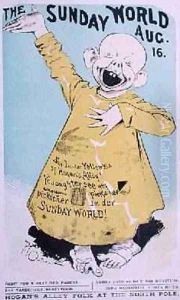Richard Felton Outcault Paintings
Richard Felton Outcault, born in Lancaster, Ohio, on January 14, 1863, is often regarded as the father of the American comic strip. His work marked a significant evolution in the world of comics and visual storytelling, laying the groundwork for future artists and genres. Outcault's most notable contributions include the creation of 'Hogan's Alley' and its central character, The Yellow Kid, which emerged in the late 19th century. This character is considered one of the first recurring characters in American comics, making Outcault a pioneer in the industry.
Outcault's career began in an era when the medium of comics was not yet fully recognized as a significant form of art or entertainment. After studying at the McMicken School of Design in Cincinnati, he moved to New York City, where he worked as a technical illustrator and contributed drawings to various publications. His work soon caught the attention of newspaper magnates like Joseph Pulitzer and William Randolph Hearst, who were eager to exploit the new medium's potential for mass entertainment and advertising. 'Hogan's Alley,' first published in the New York World newspaper in 1895, quickly gained popularity, not just for its humor but also for its commentary on the urban immigrant experience in America.
The Yellow Kid, characterized by his oversized, bald head and yellow nightshirt, became a symbol of the emerging mass media and consumer culture. The character appeared in both Pulitzer's New York World and later in Hearst's New York Journal, illustrating the fierce rivalry between the two publishers and the burgeoning importance of comic strips in American newspapers. Outcault's innovative use of sequential panels and speech balloons in his work contributed significantly to the development of comic strip language and format.
Beyond 'Hogan's Alley,' Outcault continued to innovate in the field with the creation of 'Buster Brown,' a comic strip that debuted in 1902. This series, featuring the mischievous boy Buster and his dog Tige, was also highly popular and was adapted into a wide range of merchandise, demonstrating the commercial potential of comic characters.
Richard F. Outcault's influence on the art and industry of comics is immeasurable. He not only introduced techniques and storytelling methods that would become standard in the field but also demonstrated the commercial viability of comic strips. Outcault passed away on September 25, 1928, in Flushing, New York, but his legacy lives on in the world of comics and popular culture, paving the way for countless artists and writers who followed in his footsteps.
